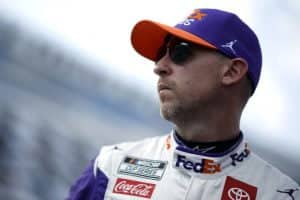Denny Hamlin’s Shocking Solution: Denny Hamlin‘s surprising solution for the Brickyard 400 involves integrating concepts from IndyCar racing. He believes this will improve competitiveness and spectator enjoyment. Hamlin suggests focusing on qualifying and addressing aerodynamic challenges posed by the NextGen car to reduce turbulence. His insights also emphasize strategic race management to optimize performance. Hamlin’s creative approach seeks to capitalize on IndyCar’s successful elements, calling for evolutionary changes within NASCAR.
Key Highlights
- Denny Hamlin proposes IndyCar concepts to improve Brickyard 400 competitiveness and enjoyment.
- Crucial test run by Goodyear and NASCAR evaluates Next-Gen car tire performance.
- Hamlin addresses aerodynamic challenges to reduce turbulence and enhance competitive racing.
- Narrow track width at Indianapolis restricts passing opportunities and dynamic racing.
- Goodyear’s findings highlight tire integrity and emphasize collaboration for performance optimization.
Introduction to the Brickyard 400 and Recent Test Run
The Brickyard 400, after a three-year hiatus from its traditional oval format, returns this July with significant anticipation as Goodyear and NASCAR recently conducted a crucial test run to evaluate tire performance and drafting dynamics for the Next-Gen car.
The test was a crucial step in guaranteeing that the race on Indianapolis Motor Speedway’s 2.5-mile circuit meets the high standards expected by both drivers and fans.
Goodyear’s focus was on gathering progressive data to tailor the best tire compound for the challenging demands of the oval track. The Next-Gen car, making its debut at this iconic venue, necessitated a thorough assessment of its handling and drafting capabilities under race conditions. Representatives from the three major OEMs—Denny Hamlin (Toyota), Kyle Busch (Chevrolet), and Todd Gilliland (Ford)—participated in the test, providing a detailed overview across different manufacturers.
While official timings and findings from the test run remain undisclosed, the collaboration between Goodyear and NASCAR highlights a commitment to enhancing race performance and safety. This meticulous approach aims to make sure that the 27th edition of the Brickyard 400 will deliver a compelling and competitive spectacle, living up to its storied legacy.

Denny Hamlin’s Perspective on the Brickyard 400
Denny Hamlin, a seasoned NASCAR driver, offers a thought-provoking perspective on the Brickyard 400, suggesting that incorporating strategies from IndyCar could enhance the race’s competitiveness and spectator appeal. Contrary to his usual advocacy for increased horsepower, Hamlin proposes that NASCAR should take cues from IndyCar’s approach to racing at the Indianapolis Motor Speedway (IMS). This shift in perspective highlights his dedication to improving the quality of racing, rather than sticking to a singular philosophy.
Hamlin’s viewpoint gains significance when considering the recent racing events at IMS, such as the Indy-Charlotte ‘Double’ duel, which, despite controversial moments, delivered intense and engaging on-track action. Hamlin believes that adopting elements from IndyCar, like aerodynamics and race strategies, could alleviate some of the current challenges faced by NASCAR at the Brickyard 400. His insights prompt a reassessment of how stock car racing can adapt to the unique demands of the IMS track, fostering a more exhilarating experience for both drivers and fans.
Denny Hamlin’s Solutions and Views on Indy’s Revised Excitement
Drawing from his fresh perspective, Hamlin presents a series of potential solutions aimed at revitalizing the excitement of racing at Indianapolis. He emphasizes the critical role of qualifying, suggesting that it could greatly influence race dynamics. Given the limitations of the NextGen car on tracks exceeding two miles, Hamlin acknowledges the challenge posed by the aerodynamics, particularly the ‘big wake’ effect that hampers trailing cars’ ability to close the gap on straightaways.
“I thought Indy was about what you would expect. I certainly think that qualifying will be a big deal.”
“I think that, in my opinion, if we could, it’s too late to do this now, but if we could slow those cars down about 10 miles an hour in the corner. And I know that we’re already running really slow, but you want to see an Indy-type race, right? Where there’s drafting, slingshot passes at the end of the straightaway.” – Hamlin
Hamlin’s creative remedy for the Brickyard 400 involves addressing these aerodynamic shortcomings. He proposes a series of adjustments designed to mitigate the wake’s impact, potentially through tweaks in car setup or changes in track configuration. By reducing aerodynamic turbulence, trailing vehicles could maintain closer proximity, thereby enhancing competitive racing.
“My fear is that… the second-place car or the third-place car, whatever it’s going to be in such a big wake that they’re not going to be able to make up that distance on the straightaway. So I certainly believe (it) will be a track position type race, just because the corner speeds were just on the edge of having not enough grip there.” – Hamlin
Moreover, Hamlin highlights the importance of strategic race management, suggesting that teams might need to adapt their approaches to qualifying and race-day tactics to optimize performance under these revised conditions. His insights reflect a holistic understanding of the interplay between car technology and race strategy, aiming to foster a more engaging and unpredictable race environment at Indianapolis.

Analysis of Track Dynamics and Potential Issues
Analyzing the track dynamics at Indianapolis reveals a critical issue: the narrow width of the track greatly restricts passing opportunities, despite the high speeds and competitive field. Denny Hamlin has emphasized that unlike wider tracks such as Kansas, Indianapolis is the ‘narrowest of narrow tracks.’ This characteristic inherently limits the potential for overtaking actions, which are crucial for thrilling and dynamic racing.
“No, it’s not going to be a Kansas or anything like that. I mean we’ve said it a million times. The wider the track, the better the racing. And that is the narrowest of narrow tracks.” – Hamlin
The challenge is further compounded by the sheer number of cars—at least 36—navigating the course at speeds approaching 200 miles per hour. In such conditions, even the smallest margin of error can lead to significant consequences, making precise driving paramount. Mathematically, one might assume that the high speeds and multiple competitors would facilitate frequent passing. However, the reality is that the track’s constricted width negates these opportunities, creating a procession-like race rather than a competitive spectacle.
Moreover, the narrow track limits the racing line options available to drivers, making it difficult to find alternative paths around opponents. This not only affects race strategies but also heightens the risk of collisions and accidents, as drivers are forced into close quarters.
Denny Hamlin said they brought a softer tire to Indy and feels they are creeping up on finding a tire that has more fall-off. What he said about Indy test and bringing the "primary" tire from North Wilkesboro to Iowa and New Hampshire. pic.twitter.com/FyODFTVPwM
— Bob Pockrass (@bobpockrass) June 8, 2024
The track dynamics at Indianapolis present significant obstacles to delivering the excitement typically associated with NASCAR racing.
Goodyear’s Assessment
Goodyear’s recent evaluation of tire performance at Indianapolis has yielded critical insights, especially following Kyle Busch’s high-profile crash at Turn 2. Despite initial speculation, Goodyear confirmed that the accident involving the RCR #8 Chevy was not caused by a tire failure. This assessment shifts the focus to other potential variables impacting performance and safety at the Brickyard.
“It seems like they’re creeping up on it. They’re going with a softer tire for Indy on the right side, (and) a heavier gauge tire on the left. So, we’re creeping into it.”- Hamlin
- Tire Integrity: Thorough analysis showed no compromise in tire structure or material, affirming their reliability under extreme racing conditions.
- Track Conditions: Factors such as track surface irregularities and temperature variations were examined, revealing areas needing attention for improved safety.
- Driver Input: Data suggested that driver techniques and vehicle handling played a significant role in the incident, emphasizing the importance of driver skill and strategy.
- Future Recommendations: Goodyear aims to collaborate with NASCAR and teams to refine tire specifications and optimize performance under varying conditions.
Goodyear’s findings are instrumental in shaping future adjustments. The collaboration between Goodyear, NASCAR, and the teams will be crucial in formulating improved strategies and solutions, potentially informed by Denny Hamlin’s creative propositions.
News in Brief : Denny Hamlin’s Shocking Solution
Denny Hamlin’s innovative approach to the Brickyard 400 offers a promising path forward for NASCAR at Indianapolis Motor Speedway. By integrating concepts from IndyCar racing and focusing on qualifying, aerodynamics, and strategic race management, Hamlin aims to enhance competitiveness and spectator enjoyment. However, challenges such as the track’s narrow width and limited passing opportunities must be addressed to realize this vision fully.
Goodyear’s assessment adds valuable insights, highlighting the importance of collaboration in refining tire specifications and optimizing performance. Together, these efforts represent a holistic approach to revitalizing the Brickyard 400, promising an exciting future for this iconic event.
Also Read : Denny Hamlin Ends Feud and Supports Frenemy in Sonoma Dispute

